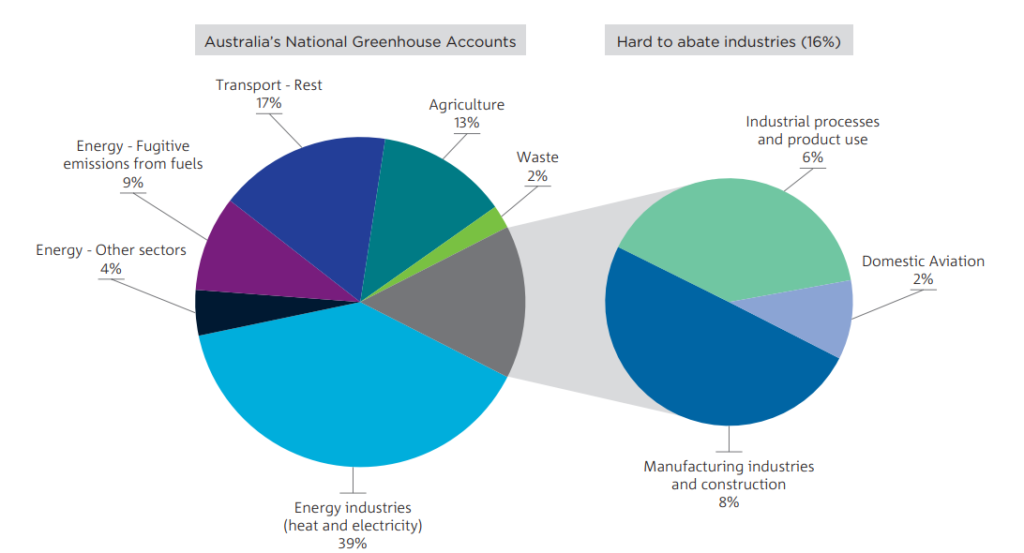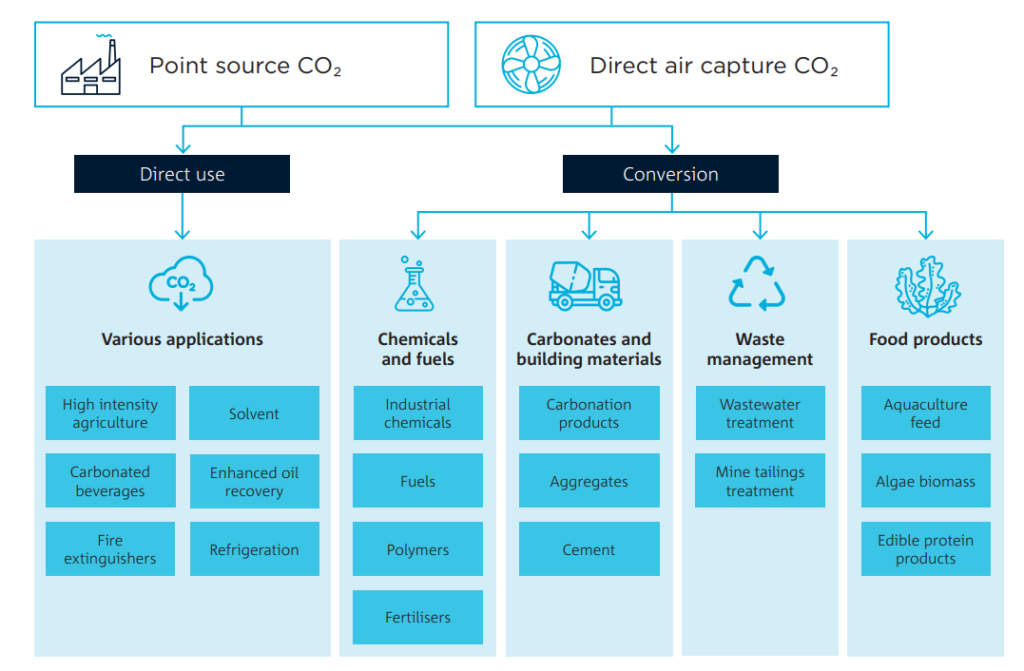The Value of Carbon – A Summary of CSIRO’s Utilisation Roadmap
The use of carbon dioxide (CO2) is a crucial part of the solutions required to reduce emissions. The CSIRO Futures Energy and Resources team has released a comprehensive roadmap for the utilisation of CO2, outlining the potential for new technologies and industries that could help reduce greenhouse gas emissions while creating valuable new products and industries. We take a closer look at the CSIRO’s roadmap, the value of CO2, and the industries that stand to benefit and the potential implications for CO2 use in Australia’s future energy mix.
Carbon Plays A Key Part In Society
Carbon, in and of itself, is not a bad thing. As the CSIRO Roadmap indiciates, carbon is a fundamental building block of life and is essential for many processes in nature and manufacturing processes. Carbon based products remain part of society and carbon, often in the form of CO2 emissions, will continue to be produced even as society decarbonises towards and beyond 2050. Finding alternate uses for these associated CO2 emissions may in some cases be the only solution to decarbonise hard to abate industries.
In 2019 alone, 82Mt of Co2-e emissions were linked to hard-to-abate industries such as cement, steel, trucking, shipping and aviation.
These industries currently rely almost entirely on carbon from fossil fuels in the production of a broad range of products, fueling long-distance transportation and in chemical transformation processes.

Image: % of greenhouse gas used by various industries in Australia
The Carbon Capture and Utilisation Opportunity
Carbon capture technology is relatively mature technology and already utilised extensively by industry in sectors that require to use CO2 in their manufacturing processes. An example of such use is where CO2 emission are captured as an output from the steam methane reforming process (the production of ammonia using a natural gas feedstock) and then reused for the manufacture of urea from the produced ammonia.
CSIRO’s Roadmap discusses the opportunity for Carbon Capture and Utilisation (CCU) to capture CO2 emitted from industrial processes that do not currently use CO2 in their manufacturing processes and repurpose it to create more valuable products for the economy.
Australia has an enviable position to capitalise on this CCU opportunity, with world class renewable energy, areas of concentrated heavy industry and the strong support of government at all levels. CCU is certainly an opportunity for Australia and should be strongly supported as a solution that will assist with the overall goal to reach zero-emissions by 2050.
Suggested Applications of CCU
The CSIRO report gives over 50 applications of captured CO2, covering four broad areas:
- Direct use of CO2
- Conversion of CO2 into chemicals and fuels
- Mineral carbonation
- Biological conversion of CO2
In summary, the main applications for utilisation of captured CO2 discussed were:
| Area | Application | Opportunity to scale |
| Direct Use | Food & Beverage | Blend capture sources to be used for beverage carbonation, food processing, and refrigeration |
| Direct Use | Greenhouses | Scale DAC facilities to capture CO2 at its source for use in greenhouses |
| Conversion of CO2 into chemicals and fuels | Methanol | Scale production of methanol using a hybrid model of natural gas and hydrogen |
| Conversion of CO2 into chemicals and fuels | Jet fuel | Increase methanol productions using hydrogen |
| Conversion of CO2 into chemicals and fuels | Polymers/olefins | Production is dependant on methanol, so again rely on hydrogen to scale |
| Conversion of CO2 into chemicals and fuels | Synthetic natural gas | Integrate into existing natural gas supply, use hydrogen and synthesis infrastructure to scale |
| Mineral carbonation | Carbonate products | Increase mineral carbonation plants and use low-purity CO2 |
| Mineral carbonation | Concrete | New processing plants and better transportation of CO2 to cement plants |
| Biological conversion | Biological conversion of C02 | Existing plants can be retrofitted to capture CO2 or CO2 must be transported to the plant |
As an underlying strategic theme, utilisation of CO2 in the economy is at the intersection of the emerging hydrogen economy and circular economy. That is, if we continue to use and capture CO2 we can avoid increasing greenhouse gas emissions while continuing to use carbon based products that our economy relies on. In many cases, the reuse of CO2 emissions can be realised when the captured CO2 can be combined with renewable energy produced hydrogen or hydrogen derived based building block chemicals (eg. ammonia), to arrive at zero or lower emission solutions as compared to the fossil fuel based equivalent processes of today.

Image: CSIRO summary of carbon capture and utilisation applications in Australia
The Roadmap
CSIRO’s report outlined four key recommendations to scale-up the utlisiation of CO2 in Australia:
1. Diversify and engage across the value chain and multiple CCU applications
As mentioned above, the report lists more than 50 potential uses or products for CCU that can help reduce carbon emissions. To make the most of these opportunities, it’s important to support their development through strong engagement both domestically and internationally. This involves clear communication about Australia’s position on CCU and our role in reducing carbon emissions.
By investing in a diverse range of CCU products, Australia can be better prepared to adapt to changing markets as CCU technologies improve. This also provides options for a wide range of industries that currently have no viable alternatives for reducing emissions. Additionally, diversifying investments can help deepen market opportunities for growth of CO2 derived products.
To ensure maximum impact and minimise investment risks, it’s important to encourage collaboration across the CO2 value chain. Transparent assessments of product lifecycle and energy efficiency will also help accurately determine the potential for reducing carbon emissions.
2. Use CCU as part of a portfolio of decarbonisation solutions
There is a mass potential for CCU as a strategy to decarbonise industries that are hard-to-abate. These industries are typically those where CO2 emissions are inherent to their processes (e.g. cement and steel), those that require carbon and sell products derived from fossil fuels (e.g. plastics and chemicals), and heavy transport industries dependent on fossil fuels (e.g. aviation and maritime).
There is no single solution to the overall challenge of net zero greenhouse gas emissions by 2050, which is why the CSIRO suggests a portfolio of decarbonisation solutions is needed, including CCU. Incentivising CCU as part of a portfolio of decarbonisation options would provide opportunities to proactively position Australia for other complementary industrial manufacturing investment. In turn, this would support Australia’s transition towards lower-emissions products, and contribute to global decarbonisation efforts.
3.Create incentives and minimise barriers to entry to reduce and bridge green premiums
Incentives and the reduction of barriers to entry can help reduce and bridge green premiums – the additional costs associated with choosing low-carbon alternatives. The cost of low-carbon CCU production can be reduced through continuous improvement, breakthrough technologies, and utilising existing infrastructure.
Increasing the cost of carbon-intensive incumbents through carbon taxes or incentives, electrification, and supply chain disruptions can increase the competitiveness of low-carbon products. Incentives such as tax credits, settling on carbon intensity accreditation, and mandates to guarantee the offtake of green CO2-based products can also help reach scale and reduce green premiums.
4. Use CCU to support or de-risk investment in existing and planned infrastructure
Leveraging existing infrastructure for the application of CCU technologies is a huge value-add to industrial and energy hubs. The most efficient deployment of CCU technologies is at sites that can leverage existing or other planned infrastructure. The use of CCU can offset some of the costs of CO2 capture through revenue generated from CCU. Hubs could incorporate multiple facilities to reduce input costs, such as co-locating hydrogen synthesis facilities with production facilities to minimise transport costs.
CCU can also support the deployment of renewables, including creating a synergy between CCU and renewable energy for the production and use of green hydrogen.
Australia has a significant opportunity to emerge as a leader in CCU by leveraging its traditional mining and heavy industry based economy and capitalising on its future renewable energy opportunities. CCU can play a crucial role in reducing greenhouse emissions, while concurrently generating viable outcomes that will transition existing heavy industry critical for the Australian economy.
To succeed, Australia needs to establish a policy framework that encourages the wide adoption of CCU and in parallel the use of captured CO2-based products in the value chain.
About Mumford Commercial Consulting
Mumford Commercial Consulting is an independent consulting business specialising in providing bespoke commercial advice and support to the Australian & Global energy and resources sectors including those transitioning to the new energy future.
